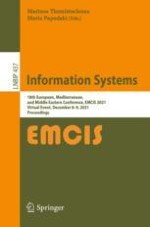This book constitutes selected papers from the 18th European, Mediterranean, and Middle Eastern Conference, EMCIS 2021, which took place during December 8-9, 2021. The conference was initially planned to take place in Dubai, UAE, but had to change to an online event due to the COVID-19 pandemic.
EMCIS covers technical, organizational, business, and social issues in the application of information technology and is dedicated to the definition and establishment of Information Systems (IS) as a discipline of high impact for IS professionals and practitioners. It focuses on approaches that facilitate the identification of innovative research of significant relevance to the IS discipline following sound research methodologies that lead to results of measurable impact.
The 54 full papers presented in this volume were carefully reviewed and selected from a total of 155 submissions. They were organized in topical sections named: Big Data and Analytics; Blockchain Technology and Applications; Cloud Computing; Digital Governance; Digital Services and Social Media; Emerging Computing Technologies and Trends for Business Process Management; Healthcare Information Systems; Information Systems security and Information Privacy Protection; Innovative Research Projects; IT Governance and Alignment; and Management and Organisational Issues in Information Systems.
